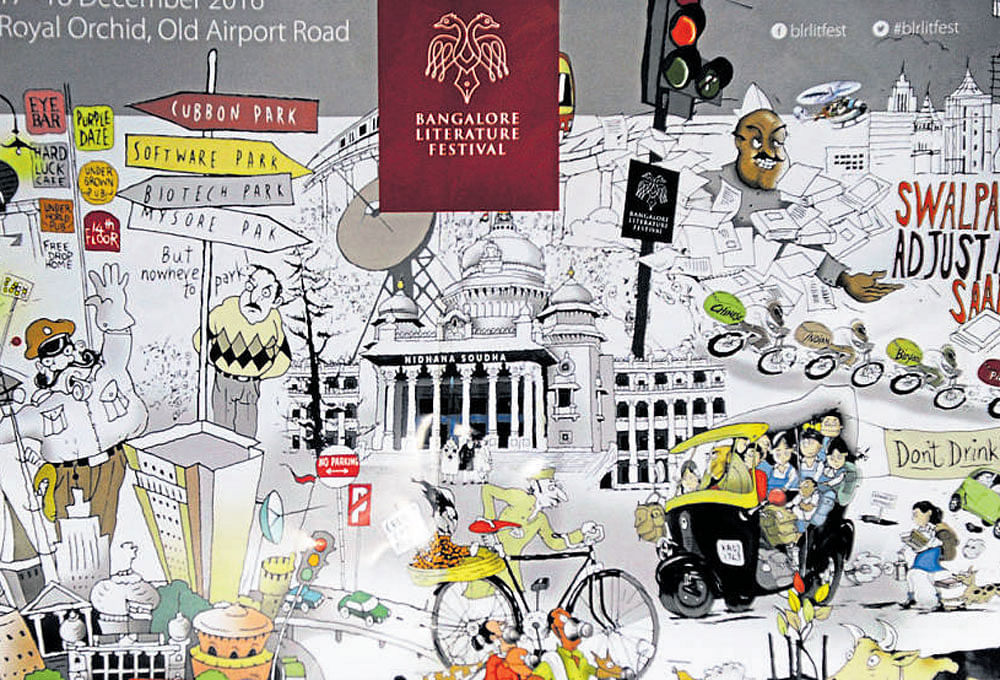Of Kempu bus, Kempegowda & MTR
Last Updated IST

The backdrop of the stage created by Paul Fernandes, known for his cartoons depicting Bengaluru.
Bengaluru might be entering its 480th year in 2017, but a lot of Bengalureans still believe the city was born with Infosys! This remark was trigger enough for speakers at the Bangalore Literature Festival here to dive deep into nostalgia for a bygone era.
As the discussion on media columnist T J S George’s book ‘Askew: A Short Biography of Bangalore” heated up, civic evangelist V Ravichander headed straight to 1969, which he called the city’s ‘glory point.’ That was the year when cycling to Majestic for a movie was the ultimate thrill. “By 1981, we had lost it. But even the period between 1981 and 1985 was a time we wanted to live in Bengaluru forever,” he recalled.
For panelist and architect Naresh Narasimhan, the best memory of the city was when the climate here was like in Kodaikanal. He said, “There were very few cars and we knew all the licence plates. I remember winning a competition as I could count seven cars in eight kilometres!”
Educationist K E Radhakrishna chose to talk about South Bengaluru of yesteryears. “I first came here in 1961, when the Kempu Bus was introduced. But landing in Kalasipalya, our school trip went around in carts,” he said.
How did the city lose its connect with its past, how did Bengaluru turn so chaotic? Ravichander blamed it on a cultural change that challenged the old ways of having living spaces close to work spaces. “We didn’t have policies that encouraged living close to work. IT created its own zones. Corruption, christened as SMS problem (Send Me Suitcase) by citizens of yore, was always part of the system. But it had not reached the levels of today, when a steel flyover estimated to cost Rs 4,000 per sqft is being pushed through.”
“You could buy 8,000 buses with that kind of money,” noted Naresh. For Radhakrishna, food was the greatest form of culture and South Bengaluru of old reflected that. “MTR, Maiyas, Adigas and Brahmins Coffee Bar are icons today,” he pointed out. Reflecting on the city’s cosmopolitan nature, Naresh drew attention to its founder, Kempegowda. He was from Dharmapuri, who migrated to Kancheepuram and then came to Magadi.
As the discussion on media columnist T J S George’s book ‘Askew: A Short Biography of Bangalore” heated up, civic evangelist V Ravichander headed straight to 1969, which he called the city’s ‘glory point.’ That was the year when cycling to Majestic for a movie was the ultimate thrill. “By 1981, we had lost it. But even the period between 1981 and 1985 was a time we wanted to live in Bengaluru forever,” he recalled.
For panelist and architect Naresh Narasimhan, the best memory of the city was when the climate here was like in Kodaikanal. He said, “There were very few cars and we knew all the licence plates. I remember winning a competition as I could count seven cars in eight kilometres!”
Educationist K E Radhakrishna chose to talk about South Bengaluru of yesteryears. “I first came here in 1961, when the Kempu Bus was introduced. But landing in Kalasipalya, our school trip went around in carts,” he said.
How did the city lose its connect with its past, how did Bengaluru turn so chaotic? Ravichander blamed it on a cultural change that challenged the old ways of having living spaces close to work spaces. “We didn’t have policies that encouraged living close to work. IT created its own zones. Corruption, christened as SMS problem (Send Me Suitcase) by citizens of yore, was always part of the system. But it had not reached the levels of today, when a steel flyover estimated to cost Rs 4,000 per sqft is being pushed through.”
“You could buy 8,000 buses with that kind of money,” noted Naresh. For Radhakrishna, food was the greatest form of culture and South Bengaluru of old reflected that. “MTR, Maiyas, Adigas and Brahmins Coffee Bar are icons today,” he pointed out. Reflecting on the city’s cosmopolitan nature, Naresh drew attention to its founder, Kempegowda. He was from Dharmapuri, who migrated to Kancheepuram and then came to Magadi.